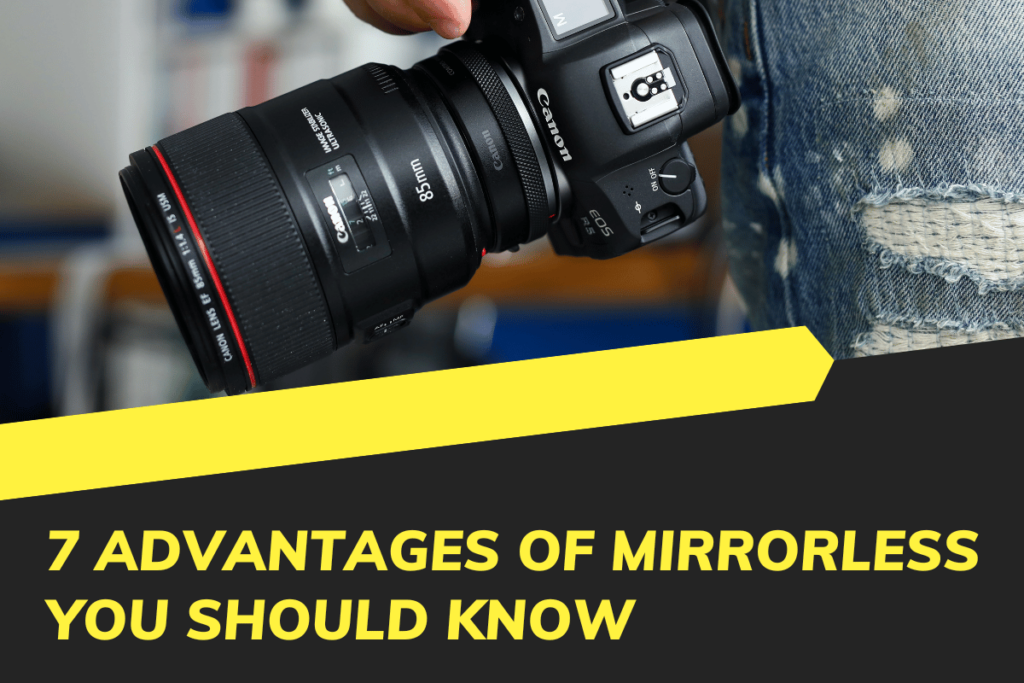
Mirrorless cameras boast some serious advantages over DSLRs. They include better video quality, faster shutter speeds, and a more discreet size. These features can seriously improve your photography game.
In this article, we’ll explore the world of mirrorless cameras. We’ll discuss their benefits. We’ll also explain why they might be your next big photography investment. Get ready to see why mirrorless is making waves in the photography world.
Size and Weight
Mirrorless cameras ditch the bulky mirror system and pentaprism that are staples in DSLRs. This means they can be more compact and significantly lighter – a real boon for photographers on the move. But don’t just take our word for it; let’s look at the numbers.
| Camera Type | Average Weight |
|---|---|
| DSLR | 800g |
| Mirrorless | 500g |
That’s a whopping 300g difference. In the world of photography, that’s the difference between feeling spry and dealing with a sore neck after a day of shooting.
Imagine you’re eyeing the Canon EOS R6, a mirrorless marvel, and its DSLR counterpart, the Canon EOS 6D Mark II. The EOS R6 weighs in at about 680g, whereas the 6D Mark II is closer to 765g. Not convinced? Let’s throw another contender in the mix: the Sony A7 III is another mirrorless heavyweight. It’s ironic, considering its weight class. The camera sits comfortably at 650g.
A more portable camera means you’re more likely to have it ready when the perfect moment strikes. Whether you’re navigating city streets or forests, it’s easier to carry.
Autofocus and Speed
Unlike DSLRs, mirrorless cameras don’t mess around with mirrors and optical viewfinders. Instead, they have phase-detection and contrast-detection pixels right on the sensor. This gives them a significant advantage in the autofocus department.
What’s that mean for you? Well, for starters, mirrorless cameras are typically faster and more accurate at locking focus. Whether you’re snapping fast-moving sports, a playful pet, or candid shots at a family gathering, you want a camera that can keep up. Mirrorless cameras say, “Challenge accepted.”
Here’s a hot tip to unleash the full potential of your mirrorless camera’s autofocus system:
- Embrace the features: Dive into eye-tracking, face-detection, and subject-tracking. These features are not just fancy terms; they’re tailor-made to ensure your subject is sharp as a tack, regardless of movement. Playing around with these settings can transform your shooting experience. It keeps everything in crystal clear focus, from fast-paced sports to spontaneous animal antics.
Whether you’re a seasoned pro or a passionate enthusiast, the responsiveness and reliability of a mirrorless camera’s autofocus system can truly elevate your photography game. So, why settle for anything less than the best shot every time? With mirrorless cameras, you’re always primed to capture life as it happens, autofocus and speed locked and loaded.
Silent Shooting
Why Whisper When You Can Be Silent?
Have you ever been in a situation where the click of your camera shutter turned all heads towards you? Embarrassing, isn’t it? Well, one of the mirrorless camera advantages really shines – silent shooting. Unlike their DSLR cousins, mirrorless cameras can snap photos in complete silence. This is thanks to their electronic shutters. So, you can leave the awkward glances to someone else.
Mirrorless cameras, such as the Sony Alpha a9 and Canon EOS R5, take the lead with their silent shooting capabilities. When switched to silent mode, these cameras become practically inaudible. It lets you capture moments without the intrusive shutter sound.
This feature is nothing short of a revolution for photographers specializing in:
- Discreet photography
- Candid shots
- Wildlife photography
Imagine photographing a timid bird without scaring it away. Capture a candid laugh without the subject becoming self-conscious. It’s all possible with mirrorless cameras.
While silent shooting sounds like a dream come true, it does come with its caveats. The use of an electronic shutter might introduce some issues under certain conditions, such as:
- Rolling Shutter Effect: This can cause distortion in fast-moving subjects, making them look like they’re out of a funhouse mirror.
- Banding under Artificial Light: Some frequencies of artificial light can create unwanted bands across your images.
Despite these limitations, the benefits of silent shooting with a mirrorless camera often outweigh the drawbacks for many photographers. It’s all about knowing when and how to use this feature to your advantage.
Continuous Shooting
One major advantage of mirrorless cameras is their ability to shoot faster and for longer than DSLRs. This is thanks to their more advanced processors and larger buffers. In simpler terms, think of it as your camera having a quicker brain and a spacious memory to store pictures temporarily before saving them.
The result? You catch more action, more smiles, and more of those blink-and-you-miss-it moments.
Comparing the continuous shooting capabilities of mirrorless cameras to DSLRs is like pitting a sports car against a family sedan in a drag race. For instance, the Sony Alpha a9 can shoot up to 20 frames per second (fps), while the Canon EOS R5 goes even further with 20 fps using its electronic shutter.
On the flip side, DSLRs, although dependable, usually max out around 12-14 fps. Below is a quick comparison:
| Camera Model | Type | Continuous Shooting Speed |
|---|---|---|
| Sony Alpha a9 | Mirrorless | 20 fps |
| Canon EOS R5 | Mirrorless | 20 fps |
| Nikon D6 | DSLR | 14 fps |
| Canon EOS-1D X Mark III | DSLR | 16 fps |
This speed difference isn’t just about bragging rights. It’s about not missing the shot where the batter hits a home run or your toddler flashes that toothless grin.
The agility of mirrorless cameras in capturing fast-moving scenes is a game-changer. Whether it’s sports photography, wildlife, or just your dog tearing through the park, the ability to continuously shoot high-quality images means you’re more likely to catch that definitive, split-second moment.
It’s about giving you, the photographer, the tools to tell a story that’s alive, vibrant, and full of action.
Image Quality and Video
You’ve probably heard chatter about mirrorless camera advantages, and guess what? The rumblings are true, especially when it comes to image quality. Mirrorless cameras are taking the lead thanks to their newer and larger sensors. They are leaving traditional DSLRs in their digital dust.
It’s not just about the size; it’s what you do with it that counts. These cameras capture breathtaking details and colors even in low-light conditions. They have higher resolution and more dynamic range.
For instance, consider the juggernauts of the mirrorless world like the Sony Alpha a9 or the Canon EOS R5. The Sony Alpha a9 boasts a 24.2MP full-frame sensor, while the Canon EOS R5 steps it up with a 45MP sensor.
But here’s the kicker – both offer an exceptional dynamic range. They make your photos vibrant and videos cinematic, even when the lighting’s not on your side.
Gone are the days when video was just an afterthought. Mirrorless cameras have catapulted to the forefront of video production. They offer features once reserved for high-end cinema cameras. 4K video is practically standard, but the real game-changer is the ability to shoot 8K, as seen in the Canon EOS R5.
This leap in quality isn’t just for the pros. Vloggers, filmmakers, and live streamers can all bring their A-game with crystal-clear footage. It’ll make viewers do a double-take.
Electronic Viewfinder and LCD Screen
Mirrorless cameras offer a game-changing solution. They have electronic viewfinders (EVF) and LCD screens. The optical viewfinder (OVF) in DSLRs only shows the scene without exposure info. In contrast, the EVF and LCD screen on a mirrorless camera give you a live preview.
This means you can see exactly how your settings—exposure, white balance, and more—affect your image in real time. It’s like having a crystal ball for photography!
With the EVF and LCD screen, tweaking your settings becomes a breeze. Adjust your aperture, and watch the depth of field change before your eyes. Playing with shutter speed? Observe motion blur or freeze in action instantly.
It’s all about getting it right before you even hit the shutter, eliminating that tiresome trial and error process. This real-time feedback loop not only speeds up your learning curve but also boosts your creative control by leaps and bounds.
Take the Sony Alpha a9 and Canon EOS R5, for instance. These mirrorless marvels boast EVFs with stunning clarity and detail, making it easier to nail your composition and focus. Their LCD screens aren’t just for show. They’re invaluable tools for shooting from high, low, or awkward angles. Using a viewfinder might not be possible.
Besides offering a live preview, EVFs and LCDs are interactive. They display a host of information, such as histogram data, ensuring your exposure is spot on. Plus, they’re incredibly beneficial for learning.
These viewfinders display the effects of different settings in real-time. They act as interactive tutorials, taking the guesswork out of photography. This lets you focus (pun intended) on capturing the perfect shot.
Customization Options and Extra Features
Touch Screen and Focus Peaking: Making Life Easier
One of the key mirrorless camera advantages is how they simplify your photography life. Touch screens—sound fancy? They sure are. Imagine adjusting your focus with a simple tap. And focus peaking? It’s like having a superhero power that highlights in-focus edges. Trust me, it’s a game-changer for getting those sharp shots.
In-Body Image Stabilization: Say Goodbye to Blurry Photos
Remember those blurry photos from that candlelit dinner? With in-body image stabilization (IBIS), those are a thing of the past. Most mirrorless cameras now come equipped with IBIS. It lets you take sharp, clear photos at slower shutter speeds without a tripod. Magic? No, just one of the fantastic mirrorless camera advantages.
Wi-Fi/Bluetooth Connectivity: Instantly Share Your Masterpieces
In an age where we share almost everything, instant photo sharing is almost a requirement. Lucky for you, mirrorless cameras often include Wi-Fi or Bluetooth connectivity. This makes it a breeze to transfer photos to your phone or computer. Whether you’re updating your portfolio or just sending a snapshot to Mom, it’s quick and easy.
Capture the moment exactly as you envision with the help of these customization options and extra features. Isn’t it great when technology not only matches but enhances your creative vision?

